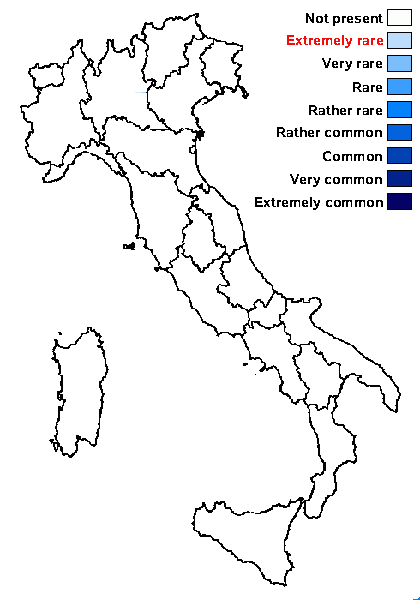Trimmatothelopsis schorica (N.V. Vodop.) K. Knudsen, Tsurykau & Urbanav.
in Knudsen & al., Herzogia, 35, 2: 470, 2022.. Basionym: Acarospora schorica N.V. Vodop. - Novosti Sist. Nizsh. Rast., 8: 991, 1971.
Synonyms: Acarospora sphaerosperma R.C. Harris & K. Knudsen; Trimmatothelopsis sphaerosperma (R.C. Harris & K. Knudsen) K. Knudsen & Kocourk.
Distribution:
Description: Thallus crustose, episubstratic, areolate, waxy white to pale brown, turning green when wet, forming up to 5 cm wide patches, the areoles dispersed or contiguous, broadly attached, round to irregular in outline, mostly 0.5-1 mm wide, usually less than 0.4 mm thick, the lower surface pale. Algal layer 40-200 μm thick, interrupted by narrow bundles of medullary hyphae. Apothecia appearing perithecioid, emergent, mostly 1(-2) per areole, at first punctiform, later slightly expanded and up to 0.4 mm across, concave, reddish brown, with a thin brown margin. Proper exciple 20-30 μm wide, continuous with the hypothecium; epithecium reddish brown, 10-15 μm high; hymenium colourless, globose in section (the exposed part less than half as wide than the equatorial diameter of the hymenium) up to 200 μm high, the hymenial gel hemiamyloid, I+ blue slowly turning red; K/I+ blue; paraphyses mostly 1 μm thick, lax in water, richly branched, with oil droplets, the apical cells slightly expanded. Asci ususally >100-spored (but sometimes with less than 100 spores), cylindrical, clavate, the tholus and endoascus K/I-, the outer wall K/I+ blue. Ascospores 1-celled, hyaline, globose, 7-10(-12) μm in diam., or broadly ellipsoid and 7-9 x 5-7 μm. Pycnidia rare, globose, 40-50 μm in diam., the conidiogenous cells ampulliform, 5-10 μm long. Conidia long-bacilliform, 5-6 x 1-1.5 μm. Photobiont chlorococcoid. Spot tests: cortex and medulla K-, C-, KC-, P-, UV-. Chemistry: thallus without lichen substances.Note: a calcicolous species known from North America and the Czech Republic. According to Knudsen & al. (2016) it could be more widespread in Europe, as it is likely to have been confused with large-spored species of Acarospora. For nomenclatural matters see Knudsen & al. (2022). To be looked for in Italy.
Growth form: Crustose
Substrata: rocks
Photobiont: green algae other than Trentepohlia
Reproductive strategy: mainly sexual

Predictive model
Growth form: Crustose
Substrata: rocks
Photobiont: green algae other than Trentepohlia
Reproductive strategy: mainly sexual

Predictive model


